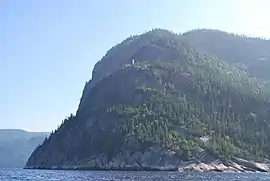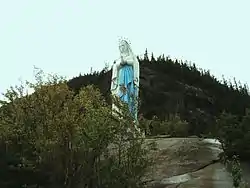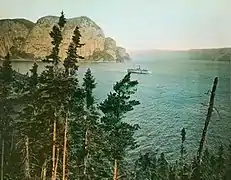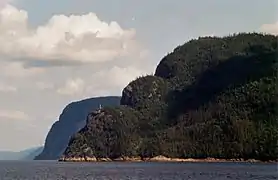Cap Trinité
The cap Trinité is a rock wall in three plateaus of the Baie Éternité overhanging the Saguenay River, the Le Fjord-du-Saguenay Regional County Municipality, in Saguenay-Lac-Saint-Jean, in Quebec, Canada. This natural elevation is located in Saguenay Fjord National Park.
| Cap Trinité | |
|---|---|
 View of Cap Trinité overlooking the Saguenay | |
| Highest point | |
| Elevation | 411 m (1,348 ft) |
| Coordinates | 48.316°N 70.333°E |
| Geography | |
| Country | Canada |
| Region | Quebec |
| Parent range | Laurentian Plateau |
| Geology | |
| Mountain type | Cliff |
| Climbing | |
| First ascent | 1967 (rock face) |
There is the Statue of Notre-Dame-du-Saguenay.
Toponymy
The Commission de toponymie du Québec writes about it: "The origin of the name would be linked to its particular form as described thus Arthur Buies:" Cape Trinité was given its name because it is actually formed by three equal caps of size and elevation, the first of which also includes three caps arranged in echelon and forming like three superimposed stages".[1]
History

Tourism
Cape Trinité is the main attraction of Saguenay Fjord National Park.
In culture
Legend
According to a legend montagnais, the cape Trinité would be the result of the combat between Mayo, the first Montagnais, and of a bad manitou. While he was paddling on the Saguenay, a creature appeared from the river to attack it. Mayo, responding only with his courage, took the creature by the tail and smashed it on the mountain. It was at the third stroke that the beast was crushed, which explains the three levels of the cape. Where the manitou hit the rock, no more vegetation grew.[2]
Poetry
Louis-Honoré Fréchette wrote, in 1873, a poem titled Le cap Trinité.
It’s an overwhelming boulder with its crest
Above the black waves, and whose powerful forehead
Dominate the fog, and challenge in passing
The wing of the storm and the shock of the downpour.
Huge pan of rock, threatening colossus
Whose flank would taunt the cannonball and the bomb,
Who rises suddenly in the cloud, and falls
In the unfathomable chasm where its base descends.
What caprice erected this dark wall?
Caprice! who knows ? Bold the mocker
These blind efforts at fertility!
This mass feeds a thousand perennial plants;
The mountain swallow nests in its crevices;
And the fierce monster has its authorship.[3]
Charles Gill was also inspired by the Saguenay capes. The song VIIIe of the collection "Le Cap Éternité followed des Étoiles filantes", entitled "Le Cap Trinité", begins as follows:
This rock which of God shows majesty,
Who draws up on the sky his three enormous bleachers,
And vertically divides its shapes into three,
It deserves three times its name of Trinity.
Its vertiginous side, scarred with scars
And full of harsh reliefs touched by the sun,
To the sacred grimoires of Egypt is the same,
When the light and the shadow mix their whims.
Browns, grays, golds, tender purples,
To these precise signs are added more vague features,
And the heavenly azure floats there according to the waves,
Who in the deep folds dart their cheerful reflections.
Is it some Titan, is it rather lightning,
Who wanted to print the word "always" here?
What meaning do these strange contours conceal?
For posterity what problem to solve[4]
Photo gallery
 Lucius O'Brien, Sunrise over the Saguenay, 1880
Lucius O'Brien, Sunrise over the Saguenay, 1880 The Saguenay River and the Cap Éternité seen from the first level of Cape Trinity near the Statue of Notre-Dame-du-Saguenay
The Saguenay River and the Cap Éternité seen from the first level of Cape Trinity near the Statue of Notre-Dame-du-Saguenay
 Cap Trinité, around 1933
Cap Trinité, around 1933 Cap Éternité in the background, and the three levels of Cap Trinité in the foreground
Cap Éternité in the background, and the three levels of Cap Trinité in the foreground
Notes and references
- Commission de toponymie du Québec - Toponym: "Cap Trinité"
- Yves Ouellet (1993). Éditions du Trécarré (ed.). The Saguenay Fjord (in French). Saint-Laurent. p. 160. ISBN 2-89249-451-6.
- Louis Fréchette, Les oiseaux de neige, The Electronic Library of the Quebec, Collection "Littérature québécoise", Volume 170, page 10
- Charles Gill, Cape Town Eternity followed by Shooting Stars, The Electronic Library of Quebec, Collection "Littérature québécoise", Volume 216, page 76